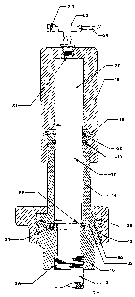Une partie des informations de ce site Web a été fournie par des sources externes. Le gouvernement du Canada n'assume aucune responsabilité concernant la précision, l'actualité ou la fiabilité des informations fournies par les sources externes. Les utilisateurs qui désirent employer cette information devraient consulter directement la source des informations. Le contenu fourni par les sources externes n'est pas assujetti aux exigences sur les langues officielles, la protection des renseignements personnels et l'accessibilité.
L'apparition de différences dans le texte et l'image des Revendications et de l'Abrégé dépend du moment auquel le document est publié. Les textes des Revendications et de l'Abrégé sont affichés :
| (12) Brevet: | (11) CA 1322379 |
|---|---|
| (21) Numéro de la demande: | 1322379 |
| (54) Titre français: | JOINT DE TIGE HAUTE PRESSION POUR MANOMETRE |
| (54) Titre anglais: | HIGH PRESSURE ROD SEALING UNIT FOR FLUID PRESSURE GAUGES |
| Statut: | Périmé et au-delà du délai pour l’annulation |
| (51) Classification internationale des brevets (CIB): |
|
|---|---|
| (72) Inventeurs : |
|
| (73) Titulaires : |
|
| (71) Demandeurs : |
|
| (74) Agent: | |
| (74) Co-agent: | |
| (45) Délivré: | 1993-09-21 |
| (22) Date de dépôt: | 1988-07-18 |
| Licence disponible: | Oui |
| Cédé au domaine public: | S.O. |
| (25) Langue des documents déposés: | Anglais |
| Traité de coopération en matière de brevets (PCT): | Non |
|---|
| (30) Données de priorité de la demande: | S.O. |
|---|
HIGH PRESSURE ROD SEALING UNIT FOR
FLUID PRESSURE GAUGES
-DAN VINH TRAN AND AMBROSE SHIU KI CHUN-
ABSTRACT
It is a common problem to devices which are used for segregating
the working fluids, such for example as the drilling mud fluid using in
drilling rig, from the pressure gauges, that the highly polished
cylindrical surfaces for piston sealing are damaged by the solids which
are carried by the working fluid. In this invention, a rod sealing
mechanism is used to eliminate the above problem. In addition, the
spare part which has to be replaced, if necessary, is far more
economical, that is, to replace the rod itself instead of the
internally-polished cylinder.
Note : Les revendications sont présentées dans la langue officielle dans laquelle elles ont été soumises.
Note : Les descriptions sont présentées dans la langue officielle dans laquelle elles ont été soumises.

2024-08-01 : Dans le cadre de la transition vers les Brevets de nouvelle génération (BNG), la base de données sur les brevets canadiens (BDBC) contient désormais un Historique d'événement plus détaillé, qui reproduit le Journal des événements de notre nouvelle solution interne.
Veuillez noter que les événements débutant par « Inactive : » se réfèrent à des événements qui ne sont plus utilisés dans notre nouvelle solution interne.
Pour une meilleure compréhension de l'état de la demande ou brevet qui figure sur cette page, la rubrique Mise en garde , et les descriptions de Brevet , Historique d'événement , Taxes périodiques et Historique des paiements devraient être consultées.
| Description | Date |
|---|---|
| Inactive : CIB de MCD | 2006-03-11 |
| Inactive : Demande ad hoc documentée | 1996-09-21 |
| Le délai pour l'annulation est expiré | 1996-03-23 |
| Lettre envoyée | 1995-09-21 |
| Accordé par délivrance | 1993-09-21 |
Il n'y a pas d'historique d'abandonnement
Les titulaires actuels et antérieures au dossier sont affichés en ordre alphabétique.
| Titulaires actuels au dossier |
|---|
| DAN V. TRAN |
| AMBROSE S. K. CHUN |
| Titulaires antérieures au dossier |
|---|
| S.O. |